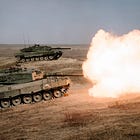Shiny Jets, New Subs, and Old Problems
Canada’s defence excitement doesn’t fix the fundamentals.
My social media feeds are full of people commenting on defence issues, usually about two topics: fighter aircraft and submarines. Most of it is very excited at the prospect of Canada thumbing our nose at Donald Trump and dumping the F-35 in favour of a different fighter, or at the idea that Canada will soon have a fleet of shiny new submarines keeping foreigners out of our Arctic waters.
I’m not going to throw cold water on all of this excitement. It is good that defence issues — after decades of wallowing in darkness — are finally receiving attention. Unfortunately, defence literacy in Canada is very low, so I do think it’s time for a reality check. After all, the Carney government is about to spend billions of dollars on defence, and it’s important to approach any plans from a dispassionate and realistic perspective.
Gripen
By far the most excitement surrounds Canada’s purchase of new fighter aircraft. I’ve written on this subject fairly extensively and will post links at the bottom of this piece should anyone be interested. Fundamentally, the issue is that Canada’s current fighter fleet is on its last legs, despite the significant improvements made to a number of aircraft in an effort to keep them operational. I won’t go into the background here, but Canada began the process to replace the CF-18 decades ago and we are a foundational member of the international F-35 programme. After a protracted development period, the issues with the F-35 appear to have been sorted out and it is now in widespread service.
Canada has bought this aircraft. Sixteen are paid for and are on the way in the first tranche of what is ultimately a total of eighty-eight aircraft. This, of course, is before the re-entry of Trump on the world stage and the decimation of Canada–US relations. Now, there is a move to abrogate the contract and go with a different, non-US fighter: the SAAB Gripen from Sweden. Unfortunately, there are issues with this:
A shift will likely further delay the replacement of the CF-18.
A fleet of sixteen F-35s is too small to be a viable capability. Sixteen jets is barely enough to keep pilots current, let alone defend anything. They bring with them all the drama caused by the F-35 — centralized spare parts, high operating costs, and a lack of control over software — with none of the benefits. We have to cater for fleet rotation, training requirements, maintenance, and attrition, and need significantly more than sixteen aircraft to do that. Ergo, we are almost certain to contract for more F-35s — if we don’t simply break the contract.
In the frenzy over the fighters, the limitations of the Gripen are often forgotten. The F-35 is a generation ahead of the Gripen. It has full stealth capability, is fully networked with NATO systems, has superior electronics, and is in service with all of Canada’s major allies. While the Gripen does indeed offer simpler maintenance and lower costs, this — in part — reflects its lower capability. Even the Gripen’s fabled “deployability” is of limited use in the Arctic, where most airfields are gravel-based.
Today (18 Nov 25), the government began signalling that it was open to discussing the Gripen — after a huge push from Sweden, including a visit by the Swedish king. Unfortunately for defence specialists, the messaging from government isn’t based on capability or military considerations but instead is focused on industrial benefits and economic considerations. This is in keeping with PM Carney’s approach to “Canadianize” military procurement.
There will be immense US pressure to proceed with the full F-35 buy, and it is very likely — if not certain — that Trump will take it personally should Canada elect to procure something else. Moreover, for NORAD (which, in my opinion, exists almost entirely to defend the US) the F-35 is the obvious choice — and a major reason it won the competition in the first place.
With all these considerations, it’s understandable that the government has taken its time in tackling this problem. In a way, they’re damned if they do and damned if they don’t. Billions of dollars are at stake, and Canadians are in no mood to kowtow to Washington. The urge to deliver a massive snub to Trump is almost overwhelming. I understand the urge to poke Trump in the eye — believe me. But — and it’s a big but — the F-35 is a more capable aircraft by most measures, and there could be immense pressure to simply proceed with what’s been contracted.
What I hope happens is what I outline in my prior musings: that Canada sucks it up and goes with a mixed fleet, despite the myriad reasons for not doing so. I also believe we need a larger fleet and that we have an opportunity to further demonstrate our resolve to the European members of NATO. In the end, this means the F-35 for NORAD and the Gripen for everything else, including NATO tasks. It also means, in my opinion, returning to a fleet of about 140 aircraft. The cynic in me says it’ll never happen.
Submarines
There seems to be less of a frenzy surrounding the proposed procurement of submarines. I haven’t written about this project a lot because I’m hardly a naval expert. That being said, submarines are a tremendous asset to any navy and would, of course, be immensely useful. Those who follow such things will know that the Carney government has narrowed the selection for a new fleet to a German–Norwegian consortium and a South Korean bid. The South Koreans have been particularly aggressive, pitching not only submarines but a complete defence package including core Army equipment. They’re also making all kinds of deals with support agencies and for infrastructure that have people very excited.
I’m in no position to assess the merits of either bid. I’m immensely relieved at the Commander RCN’s statement that the Navy will not seek to modify or “Canadianize” any new submarines. However, I’m not confident in the RCN’s ability to operate a fleet of twelve boats — the number usually mentioned. The Navy struggles to crew the ships it already has, let alone when it’s operating fifteen new frigates, new corvettes, new replenishment ships, and the like. Moreover, submarines need dedicated support facilities and maintenance, all of which must be catered for. A fleet of six to eight is much more practical and likely, but we shall see.
Defence Increases
Much has been made of the “massive” increase in defence spending in the recent budget, and it is indeed very large. But it must be remembered that Canada has been underspending on defence for many decades. There is genuine rot that must be repaired even as we are distracted by talk of fighter aircraft and submarines. This starts with properly funding spare-parts procurement, ammunition production capacity, and addressing current capability gaps. These gaps include such basics as air defence, modernized artillery, enhanced drone capability, drone defence, sealift, proper staffing, modernized personnel administration, and many others. These don’t trend on social media, but they’re what actually win or prevent wars.
Finally, the desire to speed up procurement and move quickly is encouraging. One of my criticisms for many years has been the tendency of successive governments to “punt” major decisions, to delay procurements, and to stretch them over decades to reduce costs. Further, decisions are usually driven more by political considerations than by operational necessity. Hopefully, the reforms to the procurement process serve to address some of these issues. After all, Canada is — whether we like it or not — a major country with global interests and global obligations. It’s time we acted like it.





Thanks for your highly readable and clear-eyed perspective on these major purchases. I've been following this topic with interest and appreciate your analysis. I find myself in full agreement with your views.
As always thank you for you well explained insight.
I have no technical insight here but I have two concerns , one of which , is obvious .
My first is a notion that the ties the Canadian Military command have to the Americans due to operational exposure in recent years. This may have created a sense of false security. Is their opinion somewhat tainted and therefore American leaning.
A more salient concern is that Canada can never again assume our allegiance to the USA can be trusted to include Canada’s best interest. We cannot ever again give absolute control to any foreign power. The diversification of supply in this issue may be worth the price that has to be paid.